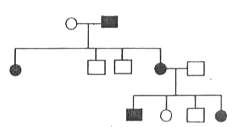As- Inheritance of Kappa particles in Paramecium is type of extra-nuclear inheritance. R- The above process is also called Cytoplasmic inheritance.
If both As and R are correct and R is correct explanation of As
If both As and R are correct but R is not correct explanation of As
If As is correct, R is wrong
If both As and R are wrong.
The correct Answer is:A
To solve the question regarding the inheritance of Kappa particles in Paramecium, we will analyze both the assertion and the reason step by step.
1. Understanding the Assertion:
- The assertion states that the inheritance of Kappa particles in Paramecium is a type of extra-nuclear inheritance.
- Extra-nuclear inheritance refers to the transmission of genetic material that occurs outside the nucleus, typically involving organelles like mitochondria or plastids, or in this case, Kappa particles.
2. Understanding Kappa Particles:
- Kappa particles are symbiotic bacteria found in Paramecium that can influence the phenotype of the organism. They are not located in the nucleus but in the cytoplasm, which is crucial for understanding their inheritance pattern.
3. Understanding the Reason:
- The reason states that this process is also called cytoplasmic inheritance.
- Cytoplasmic inheritance is indeed a form of extra-nuclear inheritance where genetic information is passed through the cytoplasm, often via organelles or other cytoplasmic elements.
4. Connecting Assertion and Reason:
- Since Kappa particles are inherited through the cytoplasm and not the nucleus, the assertion is correct.
- The reason correctly identifies that this type of inheritance is also known as cytoplasmic inheritance, which supports the assertion.
5. Conclusion:
- Both the assertion and the reason are correct, and the reason provides a valid explanation for the assertion. Therefore, the correct answer is that both the assertion and reason are true, and the reason explains the assertion.
Final Answer:
Both the assertion and reason are correct, and the reason is the correct explanation of the assertion.
---
- The assertion states that the inheritance of Kappa particles in Paramecium is a type of extra-nuclear inheritance.
- Extra-nuclear inheritance refers to the transmission of genetic material that occurs outside the nucleus, typically involving organelles like mitochondria or plastids, or in this case, Kappa particles.
- Kappa particles are symbiotic bacteria found in Paramecium that can influence the phenotype of the organism. They are not located in the nucleus but in the cytoplasm, which is crucial for understanding their inheritance pattern.
- The reason states that this process is also called cytoplasmic inheritance.
- Cytoplasmic inheritance is indeed a form of extra-nuclear inheritance where genetic information is passed through the cytoplasm, often via organelles or other cytoplasmic elements.
- Since Kappa particles are inherited through the cytoplasm and not the nucleus, the assertion is correct.
- The reason correctly identifies that this type of inheritance is also known as cytoplasmic inheritance, which supports the assertion.
- Both the assertion and the reason are correct, and the reason provides a valid explanation for the assertion. Therefore, the correct answer is that both the assertion and reason are true, and the reason explains the assertion.
Both the assertion and reason are correct, and the reason is the correct explanation of the assertion.
Topper's Solved these Questions
- ENVIRONMENTAL ISSUESBOOK - DINESH PUBLICATION ENGLISHCHAPTER - ENVIRONMENTAL ISSUESEXERCISE - Model test paper-1
100 Videos
- ENVIRONMENTAL ISSUESBOOK - DINESH PUBLICATION ENGLISHCHAPTER - ENVIRONMENTAL ISSUESEXERCISE - Model test paper-2
100 Videos
- ENVIRONMENTAL ISSUESBOOK - DINESH PUBLICATION ENGLISHCHAPTER - ENVIRONMENTAL ISSUESEXERCISE - Brain teasers-X
145 Videos
- ECHINODERMATABOOK - DINESH PUBLICATION ENGLISHCHAPTER - ECHINODERMATAEXERCISE - REVISION QUESTIONS
65 Videos
- EVIDENCES OF EVOLUTIONBOOK - DINESH PUBLICATION ENGLISHCHAPTER - EVIDENCES OF EVOLUTIONEXERCISE - CHECK YOUR GRASP
19 Videos
Similar Questions
Cytoplasmic inheritance is due to
View SolutionKappa particles of Paramecium produce a toxic substance called
View SolutionSelect the odd one w.r.t. Cytoplasmic inheritance.
View SolutionThe scientist who first discovered cytoplasmic inheritance was
View SolutionCytoplasmic inheritance is also called
View SolutionParamoecium exhibits cytoplasmic inheritance through
View Solution$ Sicke cell anaemia is a type of pleiotropy.
! Sex linked inharitance is also called criss cross inheritance.
View SolutionCytoplasmic inheritance differs from nuclear inheritance in the absence of
View Solution
In humans the above pedigree indicates the inheritance of
View Solution$ Inharitance of flower colour in mirabilis jalapa is type of polygenic inheritance.
! Polysomes are a type of chromosomes.
View Solution
